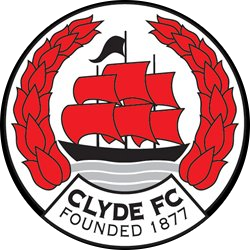
Larkhall Thistle Football Club is a football club from Larkhall, in South Lanarkshire, Scotland. Formed in 1878, "the Jags" are Scotland's oldest continuous Junior football club and currently compete in the West of Scotland League Second Division. The team plays in red and white stripes and its home ground since 1881 has been Gasworks Park.

Clyde Football Club is a Scottish semi-professional football club who play in Scottish League Two. Formed in 1877 at the River Clyde in Glasgow, the club host their home matches at New Douglas Park, having played at Broadwood Stadium from 1994 until 2022.

Parkhead is a district in the East End of Glasgow. Its name comes from a small weaving hamlet at the meeting place of the Great Eastern Road and Westmuir Street. Glasgow's Eastern Necropolis cemetery was laid out in the area in 1847 beside the Gallowgate.

Bridgeton is a district to the east of Glasgow city centre. Historically part of Lanarkshire, it is bounded by Glasgow Green to the west, Dalmarnock to the east and south, Calton to the north-west at Abercromby Street/London Road and Broad street to the north-east.
James Callaghan "Chic" Charnley is a Scottish former football player and coach. Charnley's playing career lasted nearly 20 years, with spells at Hamilton Academical, St Mirren, Hibernian and Dundee, however he is perhaps best known for his numerous spells at Partick Thistle. He also was a coach at Thistle for a short time and was briefly assistant manager of Clyde. Throughout his career, Charnley had a reputation as being a hot-head; he was sent off 17 times in a senior career which lasted for nearly 20 years.

Wishaw Football Club is a Scottish football club based in the town of Wishaw, North Lanarkshire. The club currently competes in the West of Scotland League Third Division.

Shawfield Stadium is a venue in the Shawfield district of the town of Rutherglen, South Lanarkshire, Scotland, located close to the boundary with Glasgow.
The 1920–21 Scottish Cup was the 43rd staging of Scotland's most prestigious football knockout competition. The Cup was won for the first time in their history by Partick Thistle who defeated Rangers in the final. Thistle played 11 matches in their cup run. The defending champions Kilmarnock were defeated in the second round by Aberdeen.
The Glasgow Cup is a football tournament open to teams from Glasgow, Scotland. Operated by the Glasgow Football Association, it was competed for annually by senior Glasgow clubs from 1887 until 1989. It is now competed for between the senior teams of Clyde, Partick Thistle and Queen's Park and the youth teams of Celtic and Rangers, and has used both knockout and round robin formats to determine the finalists.
Celtic competed for five trophies in the 1966–67 season and the club won all of them: the Scottish League, the Scottish Cup, the Scottish League Cup, the Glasgow Cup, and the European Cup, and completed the only ever European Quintuple. However, their European Cup victory from this season qualified them for the World Championship the following season, which they went on to lose in a playoff to Racing. Over the course of this season, Celtic scored a world record 196 goals in the major competitions they took part in.

The Glasgow Merchants' Charity Cup was a knockout football tournament open to teams from in and around Glasgow and later on in the tournament's history, teams from outwith Glasgow. Invitations were made and sent out by the Glasgow Charity Cup Committee (GCCC) at their discretion, but no criteria were ever published.
Strathclyde Football Club was a Scottish football club based in Glasgow, who played in Scottish Junior Football Association competitions from 1894 until they went out of business in 1965. They won the Scottish Junior Cup on three occasions.
Barrowfield Park was a football ground in the Bridgeton / Dalmarnock area of Glasgow, Scotland. It was the home ground of Eastern during the 1870s and Clyde between 1877 and 1898.
Braehead Park, originally known as Hibernian Park, was a football ground in the Oatlands area of Glasgow, Scotland. It was the home ground of Glasgow Hibernian from 1889 until 1890, then used by Thistle from 1892 until they folded in 1895.
Meadowside was a football ground in the Partick area of Glasgow, Scotland. It was the home ground of Partick Thistle from 1897 until 1908.
The 1978–79 Celtic F.C. season began with a significant change. Former club captain Billy McNeill took over from Jock Stein. Stein stepped down after 13 incredibly successful years, during which he led the club to numerous triumphs. His final season, however, was disappointing, with Celtic finishing fifth in the league, missing out on European football qualification, and failing to secure any silverware in the domestic cups.
Cambuslang Hibernian F.C., also known as the Cambuslang Hibs, was a football club based in the town of Cambuslang, Scotland which was originally founded in 1884. They competed in regional competitions and the Scottish Cup during the 1880s before dissolving in 1889 after being expelled from the Scottish Football Association over a payments dispute. They reformed in 1892 as a Scottish Junior Football Association club, and won the Scottish Junior Cup in 1896. Overlooked for a place in some of the more lucrative competitions organised over the next decade, they became defunct in 1908.
Bridgeton Waverley Football Club was a Scottish football club based in Glasgow. Originally founded in 1904, they competed in the Junior grade from 1923 until folding in 1962.
Glasgow Hibernian Football Club was a football club based in Glasgow, Scotland which existed for little over a year between 1889 and 1890.






